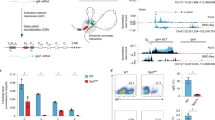Abstract
Enhancers are cis-acting activators of transcription from homologous or heterologous promoter elements of viral and cellular genes (see refs 1–6 for reviews). The activity of the simian virus 40 (SV40) (refs 7–9) and immunoglobulin heavy-chain gene (IgH) (refs 10, 11) enhancers has been reproduced to some extent in vitro and appears to be mediated by trans-acting factors both in vitro7–11 and in vivo12,13. The SV40 enhancer consists of multiple sequence motifs in two domains, A and B (Fig. 1, see ref. 14): domain B contains GT-I and -II and two TC motifs, of which only TC-II is important for enhancer activity in HeLa cells14,15; and domain A contains the P and the two Sph motifs, the repetition of which generates the sequence 5′-ATGCAAAG-3′, similar to the ‘octameric’ sequence of the IgH enhancer, (Fig. 4i; refs 14, 16), where it is important for enhancing activity17,18. Each SV40 enhancer motif is a binding site for a protein or proteins present in HeLa cell nuclear extracts19,20. Unlike the SV40 enhancer, which is active in HeLa and lymphoid B cells, the IgH enhancer is preferentially active in B cells13,17,18,21,22, suggesting that not all the trans-acting factors necessary for its activity are present in HeLa cells. However, the IgH enhancer can compete with the SV40 enhancer in vitro in HeLa or lymphoid cell extracts10,23 and in vivo in B cells13. Here we show that both human HeLa and BJA-B24 lymphoid B-cell nuclear extracts contain proteins that bind to specific, sometimes overlapping, motifs of the SV40 enhancer. Some binding is cell-specific, suggesting that it is not the same set of sequence motifs and proteins that is responsible for the enhancer activity in the two cell types. This is confirmed by our results obtained in vivo with mutated SV40 enhancers.
This is a preview of subscription content, access via your institution
Access options
Subscribe to this journal
Receive 51 print issues and online access
$199.00 per year
only $3.90 per issue
Buy this article
- Purchase on Springer Link
- Instant access to full article PDF
Prices may be subject to local taxes which are calculated during checkout
Similar content being viewed by others
References
Khoury, G. & Gruss, P. Cell 33, 313–314 (1983).
Yaniv, M. Biol. Cell 50, 203–216 (1984).
Chambon, P. et al. in Recent Progress in Hormone Research 40, 1–42 (1984).
Serfling, E., Jasin, M. & Schaffner, W. Trends Genet. 1, 224–230 (1985).
Wasylyk, B. in Maximizing Gene Expression (eds Reznikoff, W. & Gold, L.) 79–99 (Butterworth, London, 1986).
Picard, D. Oxford Surv. Eukaryotic Genes 2, 24–48 (1985).
Sassone-Corsi, P., Dougherty, J., Wasylyk, B. & Chambon, P. Proc. natn. Acad. Sci. U.S.A. 81, 308–312 (1984).
Wildeman, A. G., Sassone-Corsi, P., Grundström, T., Zenke, M. & Chambon, P. EMBO J. 3, 3129–3133 (1984).
Sergeant, A., Bohmann, D., Zentgraf, H., Weiher, H. & Keller, W. J. molec. Biol. 180, 577–600 (1984).
Schöler, H. R. & Gruss, P. EMBO J. 4, 3005–3013 (1985).
Augereau, P. & Chambon, P. EMBO J. 5, 1791–1797 (1986).
Schöler, H. R. & Gruss, P. Cell 36, 403–411 (1984).
Mercola, M., Goverman, J., Mirell, C. & Calame, K. Science 227, 266–270 (1985).
Zenke, M. et al. EMBO J. 5, 387–397 (1986).
Weiher, H., Koenig, M. & Gruss, P. Science 219, 626–631 (1983).
Ephrussi, A., Church, G. M., Tonegawa, S. & Gilbert, W. Science 227, 134–140 (1985).
Wasylyk, C. & Wasylyk, B. EMBO J. 5, 553–560 (1986).
Banerji, J., Olson, L. & Schaffner, W. Cell 33, 729–740 (1983).
Wildeman, A. G. et al. in Current Communications in Molecular Biology (ed. Gluzman, Y.) 19–26 (Cold Spring Harbor Laboratory, New York, 1985).
Wildeman, A. G. et al. Molec. cell. Biol. 6, 2098–2105 (1986).
Gillies, S. D., Morrison, S. L., Oi, V. T. & Tonegawa, S. Cell 33, 717–728 (1983).
Mosthaf, L., Pawilta, M. & Gruss, P. Nature 315, 597–600 (1985).
Sassone-Corsi, P., Wildeman, A. & Chambon, P. Nature 313, 458–463 (1985).
Klein, G., Giovanella, B., Westman, A., Stehlin, J. S. & Munford, D. Intervirology 5, 319–334 (1975).
Gidoni, D. et al. Science 230, 511–517 (1985).
Kadonaga, J. T., Jones, K. A. & Tjian, R. Trends biochem. Sci. 11, 20–23 (1986).
Gilbert, W., Maxam, A. M. & Mirzabekow, A. D. in Control of Ribosome Synthesis (eds Kjeldgaard, N. C. & Maaloe, O.) 139–143 (Munksgaard, Copenhagen, 1986).
Singh, H., Sen, R., Baltimore, D. & Sharp, P. A. Nature 319, 154–158 (1986).
Tooze, J. (ed.) DNA Tumor Viruses (Cold Spring Harbor Laboratory, New York, 1982).
Barrera-Saldana, H. et al. EMBO J. 4, 3839–3849 (1985).
Maxam, A. M. & Gilbert, W. Meth. Enzym. 65, 499–560 (1980).
Author information
Authors and Affiliations
Rights and permissions
About this article
Cite this article
Davidson, I., Fromental, C., Augereau, P. et al. Cell-type specific protein binding to the enhancer of simian virus 40 in nuclear extracts. Nature 323, 544–548 (1986). https://doi.org/10.1038/323544a0
Received:
Accepted:
Issue Date:
DOI: https://doi.org/10.1038/323544a0
This article is cited by
-
Noncoding control region of naturally occurring BK virus variants: Sequence comparison and functional analysis
Virus Genes (1995)
-
The SV40 enhancer contains two distinct levels of organization
Nature (1988)
-
Enhancer binding factors AP-4 and AP-1 act in concert to activate SV40 late transcription in vitro
Nature (1988)
-
Multiple interactions between nuclear proteins of Zea mays and the promoter of the Shrunken gene
Molecular and General Genetics MGG (1988)
Comments
By submitting a comment you agree to abide by our Terms and Community Guidelines. If you find something abusive or that does not comply with our terms or guidelines please flag it as inappropriate.



